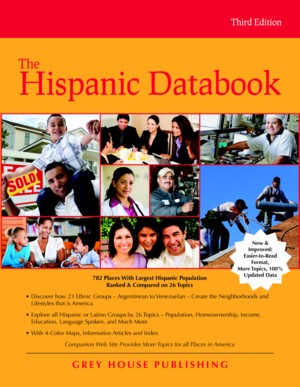
-Library Journal
"This work updates the 2004 edition and provides statistical information derived from the general 2010 U.S. Census and the 2006-2010 American Community Survey Census... Larger collections might find this volume a useful resource for statistical information on America's fastest-growing minority group."
-Booklist
"In recent years, Hispanic Americans have become the nation's largest minority, making up over 12% of the population. For a directory originally published nearly a decade ago, an update was long overdue."
-Library Journal
"The Hispanic Databook is recommended for reference collections, government documents reference collections, and other users of demographic information on the growing Hispanic origin population."
-Journal of Government Information
"This accurate, clearly presented volume of selected Hispanic demographics is recommended for large public libraries and research collections."
-Library Journal
"Not a mere reprint of census data, this book provides useful value-added information."
-Journal of Government Information
Pub. Date: September 2012
Softcover: 1,700 pages
ISBN: 978-1-61925-004-8
Price: $165.00
EBook ISBN: 978-1-61925-005-5 EBook Vendors

NEW! Buyers of the Print Edition get FREE ACCESS HISPANIC DATABOOK ONLINE
• More Places – Over 12,000 Profiles Available Online
• More Data – 10 Additional Topics Only Available Online
• Download National Profiles, National Maps
• Download State Profiles – with County & Place Data
• Hundreds of Ranking Tables – Expanded to Top 100
• Makes Researching the US Hispanic Population Quick & Easy
• https://gold.greyhouse.com/page/info_hispanic
Today, the number of Hispanics/Latinos has surpassed 50 million and is the fastest growing group in America. The Hispanic Databook takes a detailed look at this group by examining data on national, state, county, and place (city, town, etc.) levels. It contains profiles on 782 places with the highest concentrations of Hispanic/Latino population, comprising 23 ethnic backgrounds from Argentinean to Venezuelan, and includes 26 statistical topics, including Homeownership, Income, Language Spoke at Home, Jobs, Rent, and Poverty. In addition to providing significant facts and figures, The Hispanic Databook also compares and ranks all states, counties and places by all topics - allowing users to get to exactly the data they need in minutes.
Section One – National Profile
Starting with a census summary of the Hispanic/Latino population, this section provides national numbers for the 23 Hispanic/Latino backgrounds that comprise this demographic as they relate to each of the 26 topics. In addition, this section includes 23 maps to easily see population concentrations for each ethnicity. This section also includes the top congressional districts by Latino share of the population, and a historic look at the Hispanic/Latino population for the entire United States as well as the 50 states from 1980 to 2010.
Section Two – State & Place Profiles
Arranged by state, this section profiles all places (cities, towns, etc.) where the overall population is at least 125,000 OR the overall population is at least 25,000 and its Hispanic/Latino population is at least 20% of the overall population. For those states where less than five places meet either of these criteria, we have included places with total population of 10,000 or more with the highest percentage of Hispanic population, so that each state is represented by at least five places.
Each place is then arranged by topic (High School Graduates, Homeownsership Rate, Language Spoken at Home, etc.), and each topic provides the number/percentage of each ethnicity (Cuban, Mexican, Chilean, etc.) in that place. Using the profiles, researchers will learn that the median household income of Chileans in Miami, FL is $60,915 and that 35.2% of Bolivians in Providence, RI are four-year college graduates.
Section Three - Rankings & Comparisons
This section contains 1,988 charts that rank the top 10 states, counties and palces for all 26 topics and 23 Hispanic groups. All topics are ranked by number and many also by percentage, in both ascending and descending order. For comparative purposes, the U.S. figues are included in each table. Using the rankings, researchers will learn that Charlotte, NC showed the greatest growth in the Argentinean population between 2000 and 2010 (317.9%) and Yonkers, NY has the highest median home value for Hondurans ($875,000).
A useful resource for those searching for demographics data, career search and relocation information and also for market research. With data ranging from Ancestry to Education, The Hispanic Databook presents a useful compilation of information that will be a much-needed resource in the reference collection of any public or academic library along with the marketing collection of any company whose primary focus in on the Hispanic population.
Pub. Date: October 2012
Softcover: 1,700 pages
ISBN: 978-1-61925-004-8
Price: $165.00
EBook ISBN: 978-1-61925-005-5 EBook Vendors
Note: If you find this work does not fit your budget, please print out this page and bring it to your local library. There is a reasonable chance they either have a copy, can direct you to a library that does, or will be willing to purchase it for their reference collection.